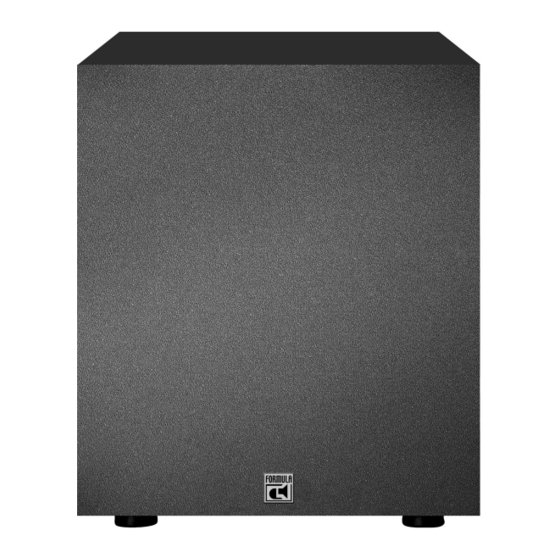Formula F-12 Kullanıcı El Kitabı - Sayfa 4
Subwoofer Formula F-12 için çevrimiçi göz atın veya pdf Kullanıcı El Kitabı indirin. Formula F-12 8 sayfaları. 12? powered subwoofer

4
receiver (check your receiver's
owner's manual).
6. SUB IN. This connection is used
to connect the subwoofer to the receiver.
Note: If you use the SUB IN connector,
the RECEIVER TYPE toggle switch
must be in the Pro Logic mode for
the crossover frequency control to
operate.
7. RECEIVER TYPE TOGGLE SWITCH.
You must set this switch to the type of
receiver mode you are using. Note: When
this switch is set to DIGITAL RECEIVER 5.1,
6.1, 7.1, the CROSSOVER FREQUENCY
control (9) does not affect the signal.
8. POWER INPUT. This connector is the
AC power in. Your subwoofer is supplied
with a removable power cord that mates
to this plug.
9. REMOVABLE FUSE HOLDER. By pushing
in and turning counter-clockwise, you can
remove and replace the fuse. Check the
rating on the fuse for proper size of your
unit.
10. FROM RECEIVER. Connects to a
receiver's speaker terminals. These binding
post, color-coded connectors are used to
hook the subwoofer to another receiver that
may not have subwoofer out or LFE (Low
Frequency Effects) output connections.
11. OUT TO SPEAKERS. If you are using
the F-12 from receiver inputs, you will hook
your main speakers to these binding post,
color-coded connections. They are NOT
used if you are using the LFE (SUB) IN line
level connection.
Away from walls:
Normal bass
Away from walls:
Normal bass
PLACEMENT
Positioning Your F-12
The subwoofer operates at low bass
frequencies which are essentially omni-
directional. That means you can place the
subwoofer almost anywhere in a room
without compromising the effectiveness of
your main stereo speakers.
Four factors need to be considered:
1) distance from your main speakers;
2) distance from a wall outlet;
3) distance from your receiver; and
4) proximity to walls and corners.
1. Distance from your main speakers.
The best placement for your subwoofer is
on the same wall as the main speakers, espe-
cially if you are matching up with small book-
shelf speakers. With tower speakers, side wall
or rear placement is also acceptable.
2. Wall outlet. Since the subwoofer re-
quires AC power, it must be placed within 10
feet of a wall outlet. We don't recommend
extending that range with an extension cord.
3. Connections to your receiver,
integrated amplifier or preamplifier. If
your receiver or integrated amplifier does
not have a subwoofer output or LFE output
(see next page), setup between the receiver
and subwoofer will be made with speaker
wire. You can basically place the subwoofer
anywhere in a normal-sized room.
4. Proximity to walls and corners.
Physical placement of the subwoofer will
have a definite impact on the frequency
Against walls:
More bass
Against walls:
More bass
DRAWING 2 - Subwoofer placement
response and the perceived amount of
subwoofer bass output. Because low fre-
quencies have long wavelengths, they are
influenced by proximity to a boundary such
as a wall or floor.
See Drawing 2 below. When you place
the subwoofer well away from a wall, it will
produce bass at a certain level. Move the sub-
woofer close to the wall, it will produce
more output (about 3dB more). Putting the
subwoofer in a corner will increase output
another 3dB (6dB more than when placed
away from walls and corners).
All this technical jargon may sound confus-
ing, but it basically means that you have a num-
ber of options, each of which produces a dif-
ferent amount of bass. For example, if you like
a lot of heavy bass, consider putting the sub-
woofer into a corner. If you like smoother,
less obvious bass, move the subwoofer out
into the room. The main thing to remember
is that there is no "right" or "wrong" place to
put the subwoofer (assuming it's less than 10
feet from a wall receptacle). It all depends on
how much bass you want.
Another reason to experiment – because
low bass waves are very large (up to forty feet
or more across!), they tend to cancel and
reinforce each other, causing places in the
room where there is lots of bass and others
where there isn't very much at all. If you walk
around your listening room while playing
music, you'll probably discover these sorts of
areas where bass is either exaggerated or
reduced.
Incidentally, moving the subwoofer around
won't affect the stereo imaging of your main
stereo system, so feel free to try various sub-
woofer positions.
In Corner:
Most bass
In Corner:
Most bass
